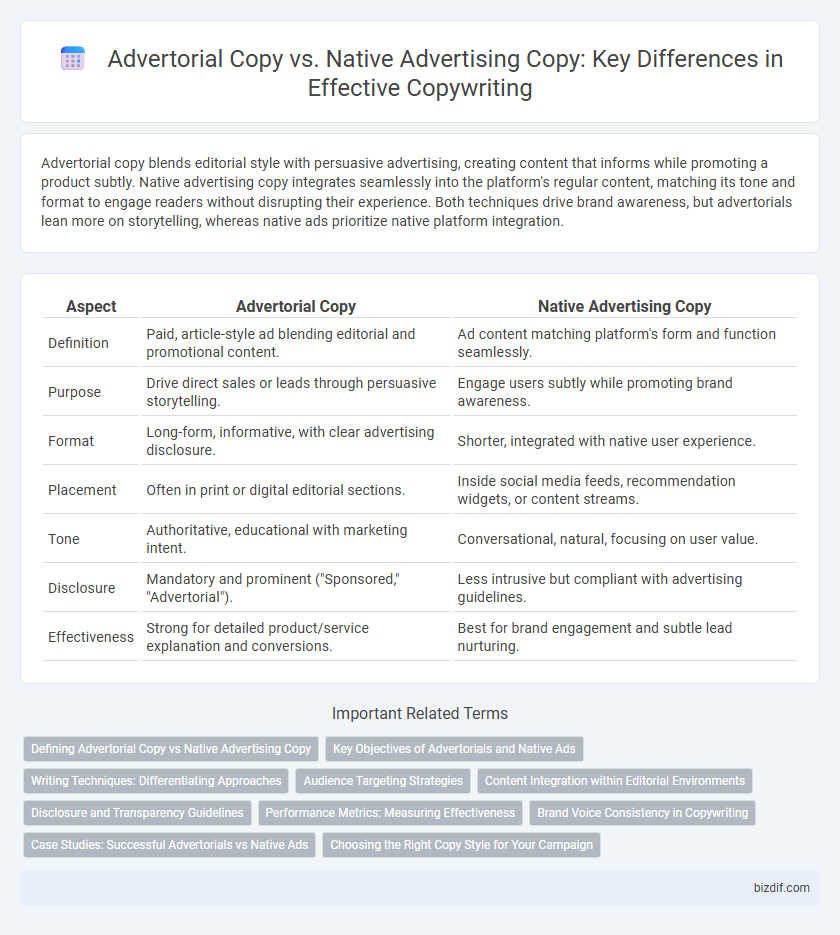Advertorial copy blends editorial style with persuasive advertising, creating content that informs while promoting a product subtly. Native advertising copy integrates seamlessly into the platform's regular content, matching its tone and format to engage readers without disrupting their experience. Both techniques drive brand awareness, but advertorials lean more on storytelling, whereas native ads prioritize native platform integration.
Table of Comparison
| Aspect | Advertorial Copy | Native Advertising Copy |
|---|---|---|
| Definition | Paid, article-style ad blending editorial and promotional content. | Ad content matching platform's form and function seamlessly. |
| Purpose | Drive direct sales or leads through persuasive storytelling. | Engage users subtly while promoting brand awareness. |
| Format | Long-form, informative, with clear advertising disclosure. | Shorter, integrated with native user experience. |
| Placement | Often in print or digital editorial sections. | Inside social media feeds, recommendation widgets, or content streams. |
| Tone | Authoritative, educational with marketing intent. | Conversational, natural, focusing on user value. |
| Disclosure | Mandatory and prominent ("Sponsored," "Advertorial"). | Less intrusive but compliant with advertising guidelines. |
| Effectiveness | Strong for detailed product/service explanation and conversions. | Best for brand engagement and subtle lead nurturing. |
Defining Advertorial Copy vs Native Advertising Copy
Advertorial copy is a paid advertisement designed to resemble editorial content, blending promotional messages with informative storytelling to engage readers subtly. Native advertising copy, however, integrates seamlessly within the platform's regular content, matching the style and tone to enhance user experience without disrupting the flow. Both techniques aim to increase brand awareness and conversion rates by delivering persuasive, contextually relevant messages tailored to the target audience.
Key Objectives of Advertorials and Native Ads
Advertorial copy aims to educate readers while subtly promoting a product, blending informative content with persuasive marketing to build trust and credibility. Native advertising copy focuses on seamless integration within the platform's environment, enhancing user engagement through relevant and non-disruptive storytelling that drives brand awareness. Both prioritize authenticity but differ in format; advertorials emphasize detailed information and brand authority, whereas native ads concentrate on user experience and contextual relevance.
Writing Techniques: Differentiating Approaches
Advertorial copy employs persuasive storytelling and a clear call-to-action to mimic editorial content while directly promoting a product or service, emphasizing benefits and addressing pain points. Native advertising copy integrates seamlessly with platform content by matching tone, style, and format, prioritizing subtle brand promotion through informational or entertaining narratives. Both techniques require audience-centric language, but advertorials focus on overt persuasion, whereas native ads rely on blending in to build trust and engagement.
Audience Targeting Strategies
Advertorial copy focuses on educating and engaging a specific target audience by blending informative content with subtle brand messaging, making it ideal for niches that value in-depth knowledge. Native advertising copy emphasizes seamless integration with the platform's content, targeting audiences based on behavioral data and contextual relevance to maximize engagement without disrupting user experience. Both strategies leverage audience insights, but advertorials prioritize detailed storytelling, while native ads highlight contextual alignment and personalization.
Content Integration within Editorial Environments
Advertorial copy seamlessly blends branded messages into editorial content, focusing on storytelling that aligns with readers' interests while maintaining an informative tone. Native advertising copy prioritizes subtle product placement and user experience, ensuring the ad feels natural within the platform's layout and style. Both strategies emphasize content integration within editorial environments to enhance engagement and drive conversions without disrupting the audience's browsing experience.
Disclosure and Transparency Guidelines
Advertorial copy integrates promotional content into editorial formats while adhering strictly to disclosure and transparency guidelines to ensure audiences recognize the material is sponsored. Native advertising copy blends seamlessly with platform content, requiring clear and conspicuous labeling to maintain trust and comply with regulatory standards such as the FTC's endorsement guides. Both formats emphasize transparent communication to balance persuasive messaging with ethical marketing practices.
Performance Metrics: Measuring Effectiveness
Advertorial copy and native advertising copy differ in performance metrics, with advertorial focusing on detailed engagement metrics such as time spent on the page and click-through rates due to its informative nature. Native advertising copy emphasizes brand lift and conversion rates by blending seamlessly with platform content, enhancing reader trust and interaction. Measuring effectiveness requires analyzing metrics like impression share, engagement depth, and conversion attribution specific to each format's unique audience interaction.
Brand Voice Consistency in Copywriting
Advertorial copy integrates promotional content within editorial formats, maintaining a persuasive tone that aligns closely with the brand's established voice to ensure authenticity and trust. Native advertising copy subtly blends ads with platform-specific content, requiring careful adaptation of brand voice to fit the medium while preserving core messaging consistency. Consistent brand voice across both advertorial and native formats strengthens audience recognition and reinforces brand identity effectively.
Case Studies: Successful Advertorials vs Native Ads
Case studies reveal that successful advertorial copy often leverages in-depth storytelling combined with clear product benefits to build trust and drive conversions, as evidenced by major brands like The New York Times, which increased subscription rates by 30%. Native advertising copy excels in seamless integration with platform content, boosting engagement metrics by up to 50%, as seen in campaigns run by platforms like BuzzFeed where content authenticity aligns with user interests. Analyzing both formats highlights that blending narrative strength with contextual relevance maximizes campaign ROI and audience retention.
Choosing the Right Copy Style for Your Campaign
Advertorial copy blends editorial content with promotional messaging, making it effective for storytelling and educating audiences within a trusted context, while native advertising copy seamlessly matches the format and tone of the platform, ensuring high engagement without disrupting user experience. Selecting the right copy style depends on campaign goals: use advertorials to build brand authority and deliver in-depth information, and native ads to drive immediate actions through subtle persuasion embedded in relevant content. Understanding audience preferences and platform norms optimizes conversion rates and enhances brand perception.
Advertorial Copy vs Native Advertising Copy Infographic

 bizdif.com
bizdif.com